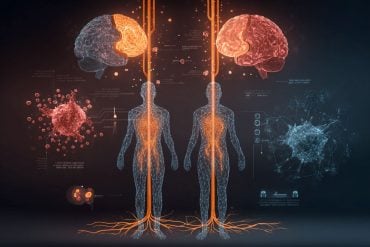Summary: A new study utilizes advanced Neuropixels probes to unravel the complexities of how the human brain plans and produces speech. The team identified specific neurons in the prefrontal cortex involved in the language production process, including the separate neural pathways for speaking and listening.
Their findings illustrate how the brain represents phonemes and assembles them into syllables, providing insights that could revolutionize treatments for speech and language disorders.
This research not only enhances our understanding of the neural underpinnings of speech but also opens the door to developing technologies for synthetic speech production, offering hope for individuals with neurological disorders affecting communication.
Key Facts:
- Neuropixels probes were used to record activities of individual neurons involved in planning and producing speech, revealing the brain’s intricate processes for language production.
- The study identified separate groups of neurons dedicated to speaking and listening, and how the brain constructs speech sounds before they are spoken.
- This research could lead to the development of synthetic speech prosthetics and treatments for a wide range of neurological disorders affecting speech and language.
Source: Mass General
By using advanced brain recording techniques, a new study led by researchers from Massachusetts General Hospital (MGH) demonstrates how neurons in the human brain work together to allow people to think about what words they want to say and then produce them aloud through speech.
Together, these findings provide a detailed map of how speech sounds such as consonants and vowels are represented in the brain well before they are even spoken and how they are strung together during language production.
The work, which is published in Nature, reveals insights into the brain’s neurons that enable language production, and which could lead to improvements in the understanding and treatment of speech and language disorders.
“Although speaking usually seems easy, our brains perform many complex cognitive steps in the production of natural speech—including coming up with the words we want to say, planning the articulatory movements and producing our intended vocalizations,” says senior author Ziv Williams, MD, an associate professor in Neurosurgery at MGH and Harvard Medical School.
“Our brains perform these feats surprisingly fast—about three words per second in natural speech—with remarkably few errors. Yet how we precisely achieve this feat has remained a mystery.”
When they used a cutting-edge technology called Neuropixels probes to record the activities of single neurons in the prefrontal cortex, a frontal region of the human brain, Williams and his colleagues identified cells that are involved in language production and that may underlie the ability to speak. They also found that there are separate groups of neurons in the brain dedicated to speaking and listening.
“The use of Neuropixels probes in humans was first pioneered at MGH. These probes are remarkable—they are smaller than the width of a human hair, yet they also have hundreds of channels that are capable of simultaneously recording the activity of dozens or even hundreds of individual neurons,” says Williams who had worked to develop these recording techniques with Sydney Cash, MD, PhD, a professor in Neurology at MGH and Harvard Medical School, who also helped lead the study.
“Use of these probes can therefore offer unprecedented new insights into how neurons in humans collectively act and how they work together to produce complex human behaviors such as language.”
The study showed how neurons in the brain represent some of the most basic elements involved in constructing spoken words—from simple speech sounds called phonemes to their assembly into more complex strings such as syllables.
For example, the consonant “da”, which is produced by touching the tongue to the hard palate behind the teeth, is needed to produce the word dog.
By recording individual neurons, the researchers found that certain neurons become active before this phoneme is spoken out loud. Other neurons reflected more complex aspects of word construction such as the specific assembly of phonemes into syllables.
With their technology, the investigators showed that it’s possible to reliably determine the speech sounds that individuals will say before they articulate them.
In other words, scientists can predict what combination of consonants and vowels will be produced before the words are actually spoken. This capability could be leveraged to build artificial prosthetics or brain-machine interfaces capable of producing synthetic speech, which could benefit a range of patients.
“Disruptions in the speech and language networks are observed in a wide variety of neurological disorders—including stroke, traumatic brain injury, tumors, neurodegenerative disorders, neurodevelopmental disorders, and more,” says Arjun Khanna who is a co-author on the study.
“Our hope is that a better understanding of the basic neural circuitry that enables speech and language will pave the way for the development of treatments for these disorders.”
The researchers hope to expand on their work by studying more complex language processes that will allow them to investigate questions related to how people choose the words that they intend to say and how the brain assembles words into sentences that convey an individual’s thoughts and feelings to others.
Additional authors include William Muñoz, Young Joon Kim, Yoav Kfir, Angelique C. Paulk, Mohsen Jamali, Jing Cai, Martina L Mustroph, Irene Caprara, Richard Hardstone, Mackenna Mejdell, Domokos Meszena, Abigail Zuckerman, and Jeffrey Schweitzer..
Funding: This work was supported by the National Institutes of Health.
About this neuroscience and speech research news
Author: Brandon Chase
Source: Mass General
Contact: Brandon Chase – Mass General
Image: The image is credited to Neuroscience News
Original Research: Closed access.
“Single-neuronal elements of speech production in humans” by Ziv Williams et al. Nature
Abstract
Single-neuronal elements of speech production in humans
Humans are capable of generating extraordinarily diverse articulatory movement combinations to produce meaningful speech. This ability to orchestrate specific phonetic sequences, and their syllabification and inflection over subsecond timescales allows us to produce thousands of word sounds and is a core component of language.
The fundamental cellular units and constructs by which we plan and produce words during speech, however, remain largely unknown. Here, using acute ultrahigh-density Neuropixels recordings capable of sampling across the cortical column in humans, we discover neurons in the language-dominant prefrontal cortex that encoded detailed information about the phonetic arrangement and composition of planned words during the production of natural speech.
These neurons represented the specific order and structure of articulatory events before utterance and reflected the segmentation of phonetic sequences into distinct syllables. They also accurately predicted the phonetic, syllabic and morphological components of upcoming words and showed a temporally ordered dynamic.
Collectively, we show how these mixtures of cells are broadly organized along the cortical column and how their activity patterns transition from articulation planning to production.
We also demonstrate how these cells reliably track the detailed composition of consonant and vowel sounds during perception and how they distinguish processes specifically related to speaking from those related to listening.
Together, these findings reveal a remarkably structured organization and encoding cascade of phonetic representations by prefrontal neurons in humans and demonstrate a cellular process that can support the production of speech.








